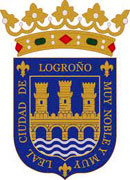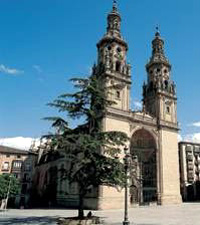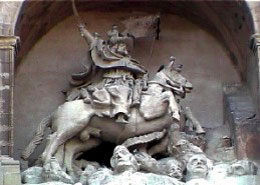Camino de Santiago - French Way - Stage 7, page 2 - Los Arcos to Logroño
Total distance: 28 km
There are a couple of Albergues in Viana as well as hostels and some hotels. There are a number of cafés, restaurants and bars where you can eat and drink before you start on the final leg of this stage of the Camino towards Logroño.
Leave Viana through the Portal San Felices and turn left down Calle la Rueda and then take a second right down a street noting the tiny pilgrim situated in a small niche on the house numbered 1. Follow the yellow arrows past the allotments and towards the N111 and after crossing the main road follow the track through the fields eventually bringing you to the Ermita de la Virgen de Cuevas (Hermitage of the Virgin of the Caves). Unfortunately this building is no longer a chapel but a private house where you will find a fountain and a picnic area where you can rest awhile.
The path takes you through fields, past woodland and finally through more woodland. You will pass a large paper factory (Papelería del Ebro) and after crossing the footbridge over a small river you have left Navarra and entered into the more famous wine region of La Rioja.
There is a newly tarmacked lane here, unusually in red tarmac, which leads to a tunnel under the N111 and under the flyover for the motorway. The path takes you through another tunnel and up towards the remains of the ancient city of Cantabria which is currently being excavated.
Heading downhill you will pass the Casa de Chozo where Doña Felisa used to stamp your credencial whilst you enjoyed refreshments under her large fig tree.
The path continues for approximately 1 kilometre and brings us to a cemetery on the outskirts of Logroño. Continue walking down Avenida de Medavia towards the 19th century Puente de Piedra over the Río Ebro, one of Spain's longest rivers flowing from here all the way to the Mediterranean.

The current bridge, restored in the late 19th century, replaced a medieval pilgrim bridge which had been built in the 11th century. The original bridge had 3 towers and is included in the Logroño coat of arms.
Logroño is the capital of the world famous La Rioja region with a population of over 150,000 and is the third largest town along the Camino Frances. As well as being a university city it is also the centre of the region's wine industry. Because of its location, like its neighbour the fortified town of Viana, the city was often a battle ground between the Kingdoms of Castilla and Navarra which is the reason the city has a fortress-like appearance.

Once over the bridge take the second right down the Calle de la Rua Vieja passing the Iglesia Maria del Palacio with its pyramid tower known as la aguja (the needle) and one of the hostels and continue down the Calle de Barriocepa into the medieval centre of Logroño.
Entering the Plaza de Santiago you will see a chequer board paving depicting sites along both the Camino Frances and the Camino Aragonés. This is actually used a board game called Juego de la Oca, something similar to snakes and ladders. In the same square is the Fuente de los Peregrinos (the Pilgrim's fountain).

The Catedral de Santa María de la Redonda can be found in the Plaza del Mercado.

Another church worth visiting is the Iglesia de Santiago el Real located on the route at the end of Calle Rúa Vieja with its impressive statue above the entrance of Santiago Matamoros (Santiago, the Moor slayer).
The current building replaces the 9th century church which had been built to commemorate the legendary battle of Clavijo. Legend states that in 844 the Christians were fighting the Moors. Greatly outnumbered by the Moorish troops and facing certain defeat a knight on a white horse appeared brandishing a huge sword, who promptly set about slaying the Moors. The Christians believed the knight was Santiago returned from the dead and from that day onwards he became known as Santiago Matamoros.
There is a large refugio as you enter the town near the Iglesia Maria del Palacio and a smaller one close to the Iglesia de Santiago as well as plenty of cafés, restaurants and bars.
Back to Stage 7 - page 1.

